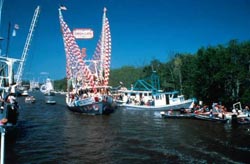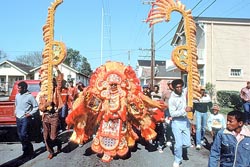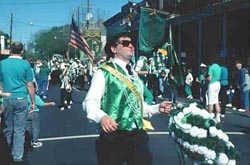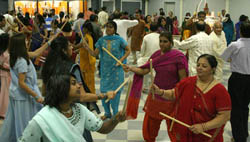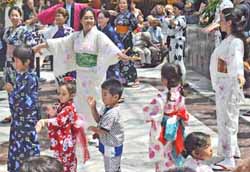Festivals, Cultural Tourism, and the Louisiana Folklife Program
By Maida Owens
When enjoying a traditional Cajun band, a Mardi Gras Indian parade, a Chitimacha basketweaver, or a Syrian foodways demonstration at one of Louisiana's folklife festivals, consider what the world would be like without any of these artistic expressions. Consider what the world would be like if we were all alike. Each of these expressive forms represents some of the most visible cultural traits of a group of people. Each cultural group has its own distinct expressive forms that developed within its own unique set of circumstances. These artistic expressions reflect the souls of diverse peoples. Without the diverse cultures of the world, we would become bland consumers of popular culture served to us by mass media.
One might think that this is impossible. While it is unlikely that the world will evolve into one, uniform culture, it is possible for us to lose many cultural forms that have come into being over thousands of years. The world is becoming a very small place. On a daily basis, traditional people around the world face pressure to adopt mass culture. With advertising budgets to back them up, commercial interests market to the world. And they not only market tangible consumer products, they market intangibles which supplant other aspects of traditional culture—music, dance, and foods.
But this doesn't have to be. More and more people are recognizing the threat to traditional culture and they are making efforts to support and encourage it.
Cultural conservation is a relatively new term that refers to the efforts of organizations and individuals to encourage and support the right of diverse cultures to continue dancing, drumming, singing, and living as they wish.
When a folklife festival presents Louisiana traditional culture, it helps to conserve tradition. By their nature, festivals are celebratory. They help us remember. Festivals are important among cultural conservation efforts because they are one of the most visible forms of support. By validating a culture publicly, its expressive forms are strengthened and, therefore, more likely to continue. In a very real sense, festivals help cultures overcome what could be called low cultural self-esteem.
As Louisiana's traditional culture receives more attention from outside the state, the tourist industry has become more aware of its potential economic value. The industry has gradually recognized that our folk cultures are a primary reason tourists come to Louisiana. The tourist comes to Louisiana to experience, or at least get a glimpse of what they have heard about. This new emphasis upon cultural resources within the tourist industry has become known as cultural tourism.
Cajun music, Creole food, jazz, historic buildings and the French language are currently among the state's most popular attractions. Still, Louisiana has much more to offer. The Isleños or Spanish-speaking Canary Islanders who settled in St. Bernard Parish during the 1760s, the British American old-time fiddlers of North Louisiana and the Florida Parishes, the old-time blues musicians throughout the state, and the locals from any Louisiana community telling stories about the area's history, culture, and people are all potential resources for local communities to consider.
Cultural tourism is predicted to become even more important to the tourist industry in the future. The exciting prospect of developing cultural tourism has not only economic, but cultural benefits. Traditional crafts would have an additional market, traditional musicians would be able to perform more regularly. And perhaps, children might not be so easily persuaded to abandon traditional ways as they become adults.
At the same time that we set out to reap economic benefits from our heritage, we must be very careful not to destroy the very thing that we promote. We must encourage research for our increased understanding of Louisiana's cultures. Carefully and thoughtfully, we must present them to the public in ways that help to insure that the traditions are strengthened and honored, not weakened or degraded.
While performing and visual art forms such as music, storytelling, and crafts receive relatively wide media exposure and are easily appreciated by audiences, there are other, less public cultural forms which may benefit from other conservation methods. The Louisiana Folklife Program has as its goal the identification, documentation, conservation, and presentation of all aspects of folk cultures in Louisiana. Located within the Division of the Arts, Office of Cultural Development, Department of Culture, Recreation, and Tourism, this program is one of forty-six state folklife programs that initiate cultural conservation programs. For example, the Louisiana Folklife Apprenticeship Program enables qualified master folk artists to work with apprentices to pass on "endangered" traditions. Previous apprenticeships have supported wooden boat building, Cajun fiddling, accordion building, Creole ballad singing, old-time blues and Mardi Gras Indian costume making and singing. Other ways to support and validate traditional culture include radio and television programs, festivals, museum exhibits, concerts, and in-school presentations. The Division of the Arts grant program enables projects such as these to happen.
Admittedly, cultural conservation is a form of cultural intervention, of interference in a culture by outsiders. But if the intervention is careful and thoughtful, it can help people within the culture to turn intervention into self-determination. Sometimes, a culture may need no more than encouragement that comes from mere recognition. But ultimately, we must provide each culture with the appropriate and specific tools necessary to present or support itself.
Often, festivals present many folk traditions that have never been presented in a festival setting before. One way that folklife festivals differ from other festivals is that the presentations are based on documentation by folklorists, anthropologists, and other cultural specialists. Some presentations are based on the research of folklorists who have volunteered to provide the results of their research. Other presentations reflect research either initiated by the Louisiana Folklife Program or assisted through public grant monies, such as the Delta Folklife Survey. Others documented traditions photographically with the support of the Louisiana Endowment for the Humanities. Many times, traditions are documented especially for presentation at a festival.
But whatever the tradition presented, remember to consider what the world would be like if we were all the same and celebrate our diversity!


